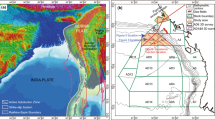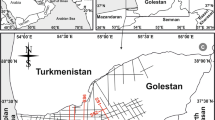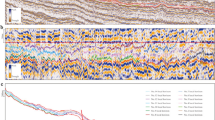Abstract
The Békés basin is a late Tertiary structural basin containing as much as 6500 m of Neogene sandstone, siltstone, claystone, and marl, most of which comprise the Pannonian sequence or group. Interpretation of well data and seismic reflection data indicates that these rocks were deposited in a wide range of depositional environments ranging from deep-basinal brackish/lacustrine to basin slope to shallow lake and delta plain to alluvial plain. Seismic reflection profiles clearly show topset, foreset (clinoform), and bottomset (basinal) depositional architecture and that the different faciès are highly diachronous. Correlations of seismic reflections with well logs indicate that the reflection patterns within each of the three main reflection groups contain characteristics that can be related to lithologies and depositional environments, which in turn reflect formational terminologies. In ascending order, these formations are (1) the Tótkomlós and Nagykörü Formations, a basal clayey marl and marl unit; (2) the Szolnok Formation, a basinal unit consisting of thick amalgamated beds of very fine grained turbidite sandstone and interbedded marl; (3) the Algyö Formation, consisting of prodelta-slope clay and marl and lesser amounts of turbidite or slumped sandstone in the lower part; (4) the Törtel Formation, consisting of delta-plain and delta-front very fine- to medium-grained sandstone and interbedded clay and clayey marl; and (5) the Zagyva and Nagyalfold Formations, consisting of upper delta-plain or alluvial-plain and inland-swamp sandstone and clay. The lower three formations are referred to as lower Pannonian, and the upper formations as upper Pannonian. Sandstones in the lower Pannonian are more compacted, and the reservoir properties are not as good as the generally friable sandstones in the upper Pannonian.
Access this chapter
Tax calculation will be finalised at checkout
Purchases are for personal use only
Preview
Unable to display preview. Download preview PDF.
Similar content being viewed by others
References
Clayton, J.L., Koncz, I., and King, D.J., and Tatár, É., Organic geochemistry of crude oils and source rocks, Békés basin; this volume. 161-185.
Elston, D.P., Lantos, M., and Hámor, T., High resolution polarity records and the stratigraphic and magnetostratigraphic correlation of late Miocene and Pliocene (Pannonian s.l.) deposits of Hungary; this volume, 111-142.
Jámbor, É., Balázs, E., Balogh, K., Bérczi, I., Bóna, J., Horváth, F., Gajdos, I., Geiger, J., Hajós, M., Kordos, L., Korecz, A., Korecz-Laki, I., Korpás-Hódi, M., Köváry, J., Mészáros, L., Nagy, E., Németh, G., Nusszer, A., Pap, S., Pogácsás. Gy., Révész, I., Rumpler. J., Sütö-Szentai, M., Szalay, A., Szentgyörgyi, K., Széles, M., and Völgyi, L., 1987. General characteristics of Pannonian s.l. deposits in Hungary; Proc. 8th Cong., Reg. Comm. on Mediterr. Neogene Stratigraphy, Budapest September 15–22, 1985; Hung. Geol. Inst. Ann. Rept. 70, 155-167.
Mitchum, R.M., Vail, P.R., and Sangree, J.B., 1977, Stratigraphic interpretation of seismic reflection patterns in depositional sequences; in Payton, C.E. (ed.), Seismic stratigraphy-applications to hydrocarbon exploration; Amer. Assoc. Petrol. Geol. Memoir. 26, 117–133.
Phillips, R.L., Révész, I., and Bérczi. I., Lower Pannonian deltaiclacustrine processes and sedimentation, Békés basin; this volume. 67-82.
Pogácsás, Gy., 1987, Seismic stratigraphy as a tool for chronostrati-graphy — Pannonian basin; Proc. 8th Cong. Reg. Comm. on Mediterr. Neogene Stratigraphy; Budapest, September 15–22, 1985; Hung. Geol. Inst. Ann. Rept., 70, 55-63.
Pogácsás, Gy., and Révész, I., 1987, Seismic stratigraphie and sedimentological analysis of Neogene delta features in the Pannonian Basin; Proc. 8th Cong. Reg Comm. on Mediterr. Neogene Stratigraphy, Budapest, September 15–22, 1985; Hung. Geol. Inst. Ann. Rept.. 70. 267-273.
Pogácsás, Gy, Mattick, R.E., Elston, D.P., Hámor, T., Jámbor, Á., Lakatos, L., Lantos, M., Simon. E., Vakarcs, G., Várkonyi, L., and Várnai, P., Correlation of seismo-and magnetostratigraphy in southeastern Hungary; this volume, 143-160.
Szalay, A., and Szentgyörgyi, K., 1979, Subdividing the lithology of Pannonian deposits based on well data, and using trend analysis; Hung. Acad. Sci., Rept. of the Earth and Mining Science Div., 12,(4), 401–423.
Author information
Authors and Affiliations
Editor information
Editors and Affiliations
Rights and permissions
Copyright information
© 1994 Springer Science+Business Media Dordrecht
About this chapter
Cite this chapter
Molenaar, C.M. et al. (1994). Stratigraphic Framework and Sandstone Facies Distribution of the Pannonian Sequence in the Békés Basin. In: Teleki, P.G., Mattick, R.E., Kókai, J. (eds) Basin Analysis in Petroleum Exploration. Springer, Dordrecht. https://doi.org/10.1007/978-94-011-0954-3_5
Download citation
DOI: https://doi.org/10.1007/978-94-011-0954-3_5
Publisher Name: Springer, Dordrecht
Print ISBN: 978-94-010-4412-7
Online ISBN: 978-94-011-0954-3
eBook Packages: Springer Book Archive




